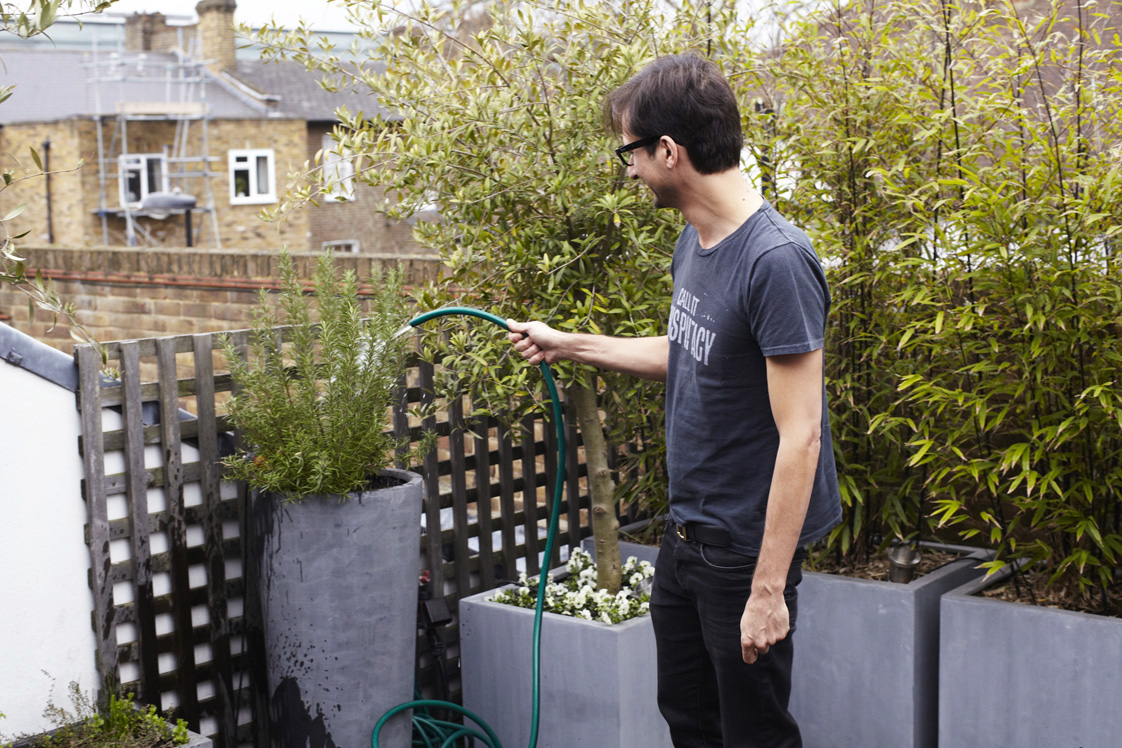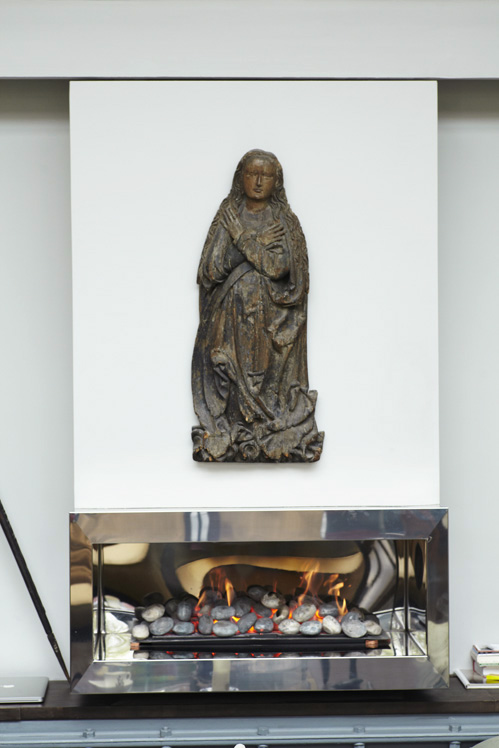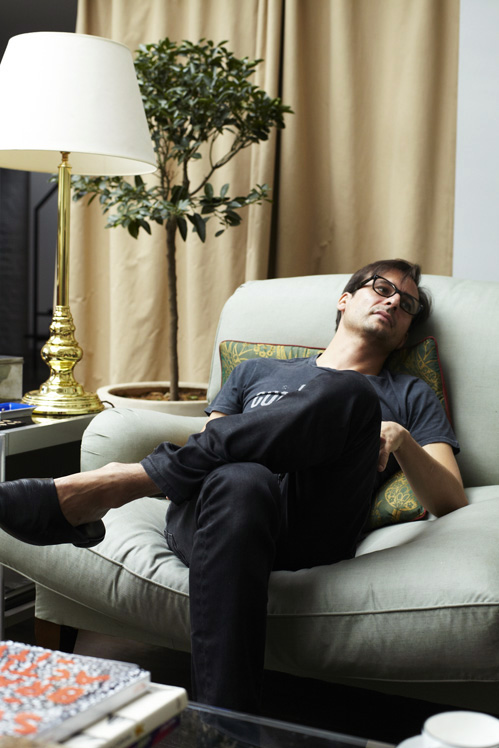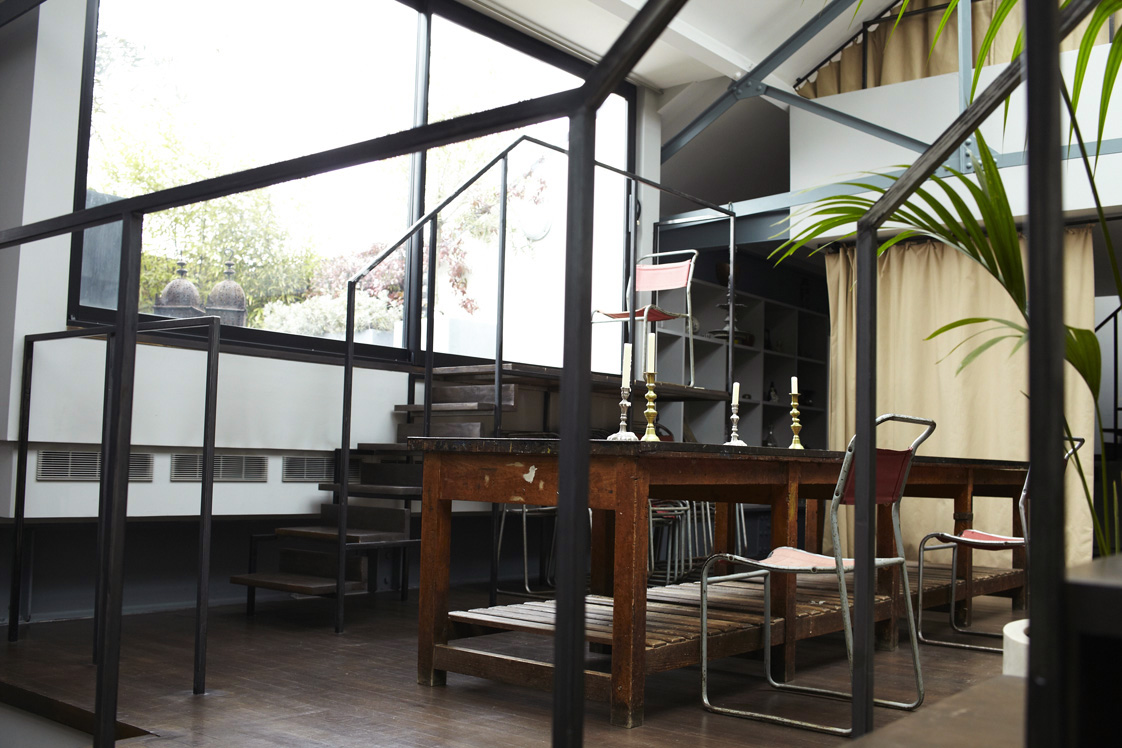I first met photographer Hugo Tillman two years ago. Back then, we were working on a photo shoot at his house and I can clearly remember being enthralled by his attention to detail, which shows itself all throughout his home. The three-storey building is located on a quiet side street in Holloway, a neighbourhood as-yet to be discovered by the notorious East London hipsters and praised for its convenience and diversity by Mr. Tillman.
Hugo impresses with charm and intelligence. Whilst firing questions at him, he serves us Chinese tea in beautiful porcelain and answers my questions openly with depth and calmness. Born in London, raised in New York, he is a true cosmopolitan. After film studies in L.A., Hugo went on to assist Mario Testino in Paris and got drawn into photography, a medium which he celebrates as a ‘catalyst for dialogue.’ He has worked for world renowned magazines such as L’Uomo Vogue, whilst simultaneously delving deep into artistic projects and scratching far beneath their surfaces.
His home mirrors his mind’s freedom: a light-flooded, large living space, divided by precious fabrics into several levels, a downstairs office and studio space – everything but conventional. Since purchasing the building in 2008, Hugo has devoted a lot of time and effort into transforming it into a one-of-a-kind space. Everything in this treasure chamber is custom-made, from the hand-pounded curtain rings to the ensemble of sofas. A conglomeration of rare books, floral china, ancient objects, Asian caskets, paintings and framed photographs make for a very personal and unique interior.
This portrait is part of our ongoing collaboration with ZEIT Online who present a special curation of our pictures on their site. Have a look here!































You were born in London and then moved to New York. When and why did you move?
That was when I was four years old because my father died and my mother got a job in New York at Christie’s.
So you spent your whole childhood in New York? Why did you decide to come back to London?
Yeah I did. Well, I actually first moved to Berlin in 2007. It was primarily a reaction of living in the Bush time, I just couldn’t deal with America any more. It was so great in Berlin with the good weather, but then the winter came, so I decided to come here.
Why did you decide to go to Berlin in the first place?
On paper it looked perfect. But I guess I found it to be such a small town; seeing the same people all the time, it’s just not that cosmopolitan. I stayed for six months before moving to London.
Can you describe what you did after school?
After school I went away to Los Angeles for college and studied film and anthropology. My first job was working as an assistant to Mario Testino, so I moved to Paris. I was just flying all over the world, which I found to be amazing at first but then I got really freaked out by all that. I was more a nerd than into fashion, so then I went to study in Amsterdam: graphic, objects and South Asian art and culture. I went on a long trip to Asia and then did my first commercial work as a photographer in Hong Kong in 1997. Coming back from that trip, I sat on a plane, got upgraded, then got seated next to Helen Gurley Brown who started Cosmopolitan Magazine and this other lady who ran Hearst International Magazines. That woman offered me to move to Prague or to Buenos Aires to act as a photographer for a starting up Hearst magazine. Actually I regret not choosing Buenos Aires! Instead I went to Prague and lived there for a year and worked for those magazines. Soon after, I realized that it was too removed from the rest of the world and really provincial. Afterwards, I worked as Photo Editor for Very Magazine in New York and then went to grad school in New York, did an MFA in photography at Pratt. After that I started doing my own work.
Did you enjoy working for Mario Testino?
At first it was very glamorous and exciting; pretty girls, travelling and all that. He is a very remarkable, interesting, and intelligent person, and I learnt a lot from him. The way he works is very different than I do, but I saw how much of a business it was. The business was much more of a focus than the actual photography.
Is there anything you miss about New York that you can’t find in London? How do the cities differ in your opinion?
Honestly, I don’t really miss much apart from the people. Maybe sometimes the efficiency. Being here, I realize that there was a level of insecurity and neurotic behaviour existing in New York. From my perspective that was very much associated with the velvet ropes that first dealt with in fashion when I worked for Mario. Everything was open, whatever you wanted to do. Once that ended, all of that stuff closed instantly. Institutionally culture is a place for the patrons and not so much for the public. It seems there’s a very different value structure going on in New York than here. Here I find life much more calm, yet it is the most culturally active city in the world, so one can easily interact with the museums, galleries, concerts, discussions and lectures; it is all open. The museums are free apart from special exhibitions and when you walk into a gallery, the girls in the front say ‘Hello’ to you – that is very different to New York. And of course the incredible cultural diversity in such a small geographic area. It is the most cosmopolitan city in the world. Also, being able to access Europe with ease is really special.
How did you get into photography initially?
I was working freelance as Production Assistant on music videos and commercials. The hours were really crazy and I wasn’t making much money. A friend of mine was dating the Features Editor of W at the time, and she suggested to me to work as a Fashion Photography Assistant. The hours are short, the food is good, and all the girls! It was the time of the fax machine and I was too nervous to call anybody. So she gave me a list of photographers none of whom I knew, I had no idea who Mario Testino was, and I faxed all their agents. Mario Testino was the only one who got back to me. I was taking photography at school but I was much more interested in film.
How come you didn’t go back to making films?
One thing was the money involved in film, especially then, people weren’t shooting on video, so it was really expensive and you needed tons of people. I use the camera very much as a vehicle to act as a catalyst for dialogue. The photographic camera is just like a key to any door, you walk in with it and can talk to a person, collaborate with them. That just gave me a lot more freedom.
Do your prefer film or digital?
I do both. I am using an 8/10 large format camera for my current work.
Can you tell me about the project ‘Film Stills of the Mind’ and why you decided to do this project in China?
When I was at Pratt, Oriental contemporary art was not really in the curriculum, yet in all the art publications like Frieze and Art Forum they were starting to write about China. I was interested so I went there, but I saw an aesthetic that I wasn’t comfortable with. Both of my parents were antique dealers, who are extremely aesthetic people. They had very rigid ideas as to what good and bad taste was but from a very European point of view, which I realized was a problem for me. I think that it’s very dangerous to be aesthetically imperialist and this is an issue very much with China. I began to do the project really to understand what was going on, and to gain an appreciation for the aesthetics and the qualities, which informed the aesthetics to understand that language. It then became something that I got completely obsessed with. Beijing’s doors were wide open to me and everybody invited me in. It is a small scene and extremely warm so I felt welcomed into it, which is why I think I spent three years doing it.
Are you planning on going back to China?
I go back regularly to China and feel that Beijing is just as much home as London and New York.
Can you as well explain the upper class project and the idea behind it?
It was quite personal. My mother married a man who was part of that world. It is a world very different from our own background, which we became a part of and suddenly I found myself in country clubs feeling very odd and dark. That project began by me negotiating and trying to understand the place in which she was living. You could go to one lady’s house half the day and she would be anti-abortion and then the next day you are going to meet somebody who is extremely liberal and spreading what I would call positive ideas. It was quite a conflicted project which towards the end became almost misogynistic. I definitely got mean with the camera.
Were they not afraid that you would give a critical point of view through your camera?
I don’t think they ever expected me to do what I did. Some of the photographs look quite kind to me, but then often to the viewers from my world they look absurd, and there is this aesthetic judgement going on which I don’t think is fair.
How did you go on after these two major projects?
There was one called the ‘Maplab’, a research lab and massage parlour travelling around to different museums, and then I did another project which was called `Daydreams of the Mind,’ which I did with the Cuban government. That was right when Raul took power and Fidel left. They were looking at some of the contemporary issues in Cuba at the time. One issue that they were looking at were the transvestites, who were suddenly allowed to dress up like women. This was previously not allowed since you were supposed to look the way you looked in your ID card. Gabriela Castro was hanging out in that scene and suddenly it would be hypocritical to have laws against it, so they changed it and did a print and TV campaign. There was a big machismo reaction against that because all these guys have been taught that it was wrong. But there were also other topics. It was strange because it was completely controlled by the government. It was the first set-up photography project that happened in Cuba where they controlled the actors, the costume, and the location.
After that I started an Art Practice Research degree at The Ruskin School of Oxford. I was in that programme for two years but left last May, since they changed the fee structures; they went from calling me a home student to a foreign student. The fees went up four times and so I decided against it. But the next project went back to that research I did at the Tropenmuseum, where I started looking at my ancestry and my great grandfather who was a German Jew who had lived in Hamburg. He left Germany in the 30s, went to Amsterdam but couldn’t really do much business there at the time. So he began obsessively collecting Indonesian objects. He was a collector of things in Germany, he was significant in the Hamburg intellectual and artistic scene and gave a lot of stuff to the museums there. I studied this collection, which was over 2700 objects, in a way to try and map his mind. I was also looking at thinkers like Aby Warburg, who is also German family from Hamburg.
I was looking at the webs of relationships in a non-linear fashion to understand a greater whole, more of a holistic way of thinking. I thought if I could understand his collection and his life, I might then understand the way mine works and thus understand myself better. I knew that the spiritual act of looking at ancestors was significantly profound, but I couldn’t see exactly why because I was in it.
Stephanie Rosenthal, a friend of mine, the only person I really show my work for feedback at present, suggested a book of critical essays by Maurice Blanchot on the story of `Orpheus and Eurydice.’ In these essays he speaks about a concept called `The Other Night,’ which he identifies as the period when Orpheus goes down into Hades to find Eurydice: he calls her name and she answers, but it’s dark and when he turns around he can’t see her and she disappears. He starts speaking about `The Other Night’ in a way that describes creativity and inspiration, and the things which when looked for, fail to show or disappear, and when you’re in `it’ you don’t really know until you’re out, when you can finally see it. She wanted me to realize that in looking back, it was the place of inspiration but it wasn’t the actual work.
So I began to do these black pictures, which are the works that I have in production for my next show. From afar, the canvas looks black, you walk into the room and there are just black photographs, and then, when you get close, you begin to see images coming out. They are much more about the emotion and the psychological place of `The Other Night’ then the specific references in the images themselves. All the stuff comes from really ethnographic museums across Europe, like the Venus of Willendorf in the Natural History Museum in Vienna. I spent a lot of time in the Powell-Cotton Museum in Kent and Pitt Rivers in Oxford, La Specola Florence; I went all over the place.
You also work for magazines like Pop and L’Uomo Vogue…
L’Uomo Vogue is really the main one. There was an article in Corriere della Sera about the Chinese Film Stills project and I got a call from Franca Sozzani asking me to come and meet her. It seemed like an honour for me at that time, so I went there and started working for them almost monthly ever since. They are really nice people to work with, super relaxed and completely free. I get to meet interesting people and have discussions.
Would you say you enjoy it as much, in a different way, as working on your own projects?
Yeah, it’s completely different. It’s inspirational because you always meet new people. And technically it keeps you sharp, since you are constantly working. I do enjoy it a lot.
Can you tell us a bit about the house? When did you find it?
I bought it three years ago. I first saw it in 2008, it was the first place I saw. I had looked everywhere, I looked at a hundred places, I was constantly looking, like a job. This one turned out to be the one I liked the most. It was was the bottom of the real estate market when everything had crashed, and the couple who lived here were getting divorced and were having a horrible time: one lived downstairs, one lived upstairs, and the children lived in-between. The children were going down or up, the couple wouldn’t see each other. So the longer I waited, the better the deal got. I had seen it in November and I ended up getting it in June, the price dropped by a fortune.
How did it look like when you moved in? Was everything already set up like this?
Structurally it was all the same, it just had been taken care of really badly. What I did was all cosmetic but it’s unbelievable how much cosmetic work takes. My mother is a decorator so she works with people here and specifically this one guy, Andrew Webb, who has a lighting company called Collier Webb. He helped me a lot with getting in touch with different artisans or manufacturers. We had all of the rods and rings for the curtains made by a blacksmith, they are all hand-pounded. Everything was pretty much handmade. That is such a big difference between England and America, you can have sofas custom-made by hand, cheaper than those sold in a department store. The floors were done by a friend of mine, Mark van Eyck, who is actually in line of the German Royal family – he is the son of the Princess von Hessen, Grace Jones’s boyfriend. Anyway, he did the floors, all with special dye.
Sounds like you’ve put a lot of work, effort and money into it!
Crazy amounts of effort and money. It’s an obsession!
Is there a favourite piece, anything in particular?
No, not really. I just bought a Pomodoro bed, which was an art purchase, because I don’t really need a bed. But I thought it was just so amazing. All of the things really have significance, most of them are from my family. That’s my great grandmother there, she was American and then moved to Hamburg and married the man I was talking about, my great-grandfather. My grandmother painted that in the night that my father killed himself. It’s kind of intense, a lot of women around.
How about the area?
Holloway! I adore it! I really really like it. I guess being from New York I like that it’s so urban and more than anywhere I’ve ever been. There is every different kind of person on the street. You see women in Purdah, Hissitic Jews, Moslems from Africa, and traditional African clothes. And now it’s quite nice, they have rehabilitated the area by building dorms for students down Holloway Road, which brought youth, and changed the businesses and the feel of the neighbourhood. But I really like it. And it’s super convenient!
You have your studio downstairs. How do you find living and working in the same place?
I find it really good. I mean in a way it’s a separate place for me… I go down there during the day and spend the day there, doing stuff, and then come up to the house for meals in the afternoon or evening. Although I watch movies downstairs. It’s really great! It was a dream of mine for a long long time. I really like it. I have the opportunity to focus on my artistic practice 24 hours a day. It is my little corner of the world. I keep my work private now. Once it’s completed, the only way to see it is to come to my studio.
Thank you Hugo for the interview and a really nice afternoon!
Interview and text by Lilli Heinemann
Photography by Thomas Lohr
